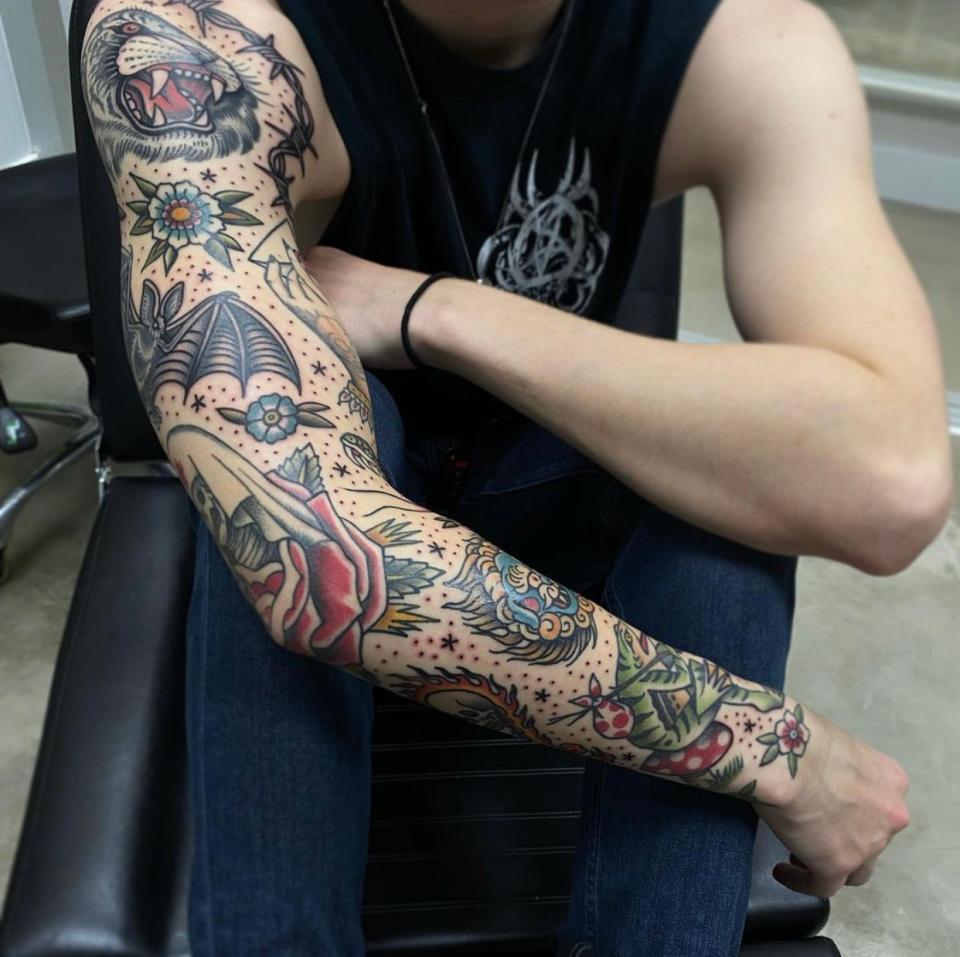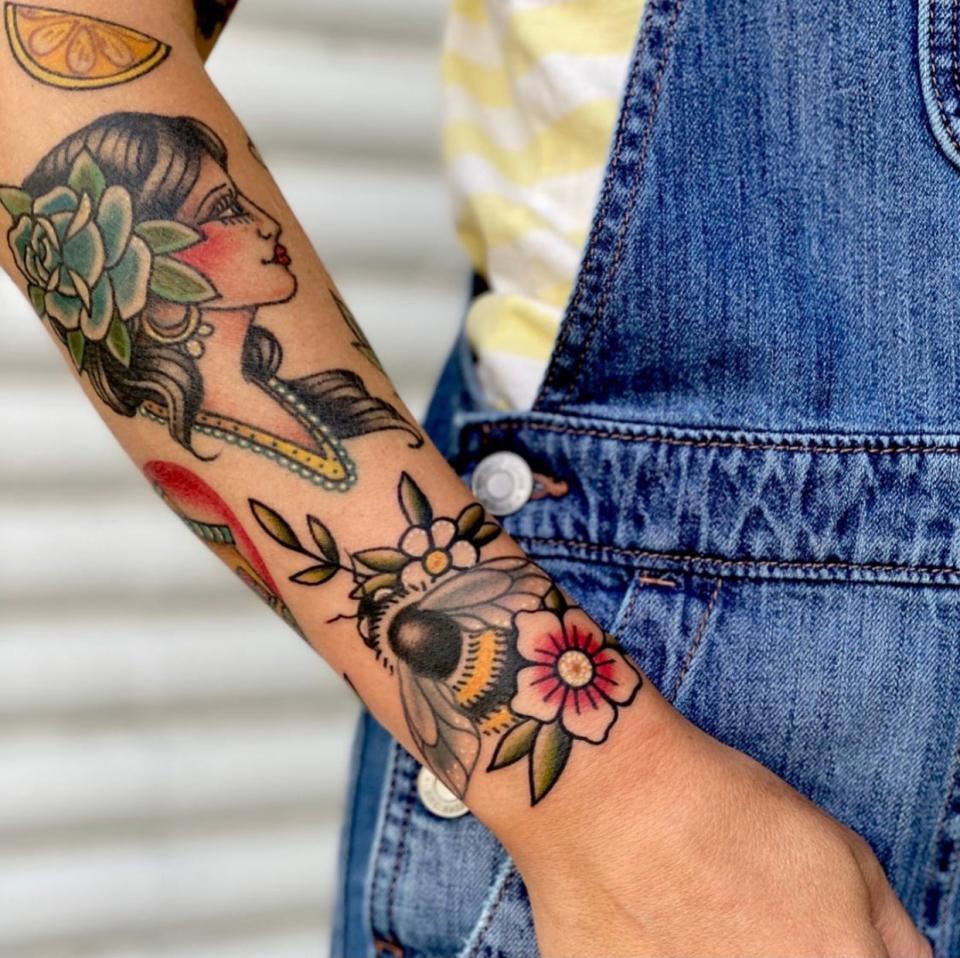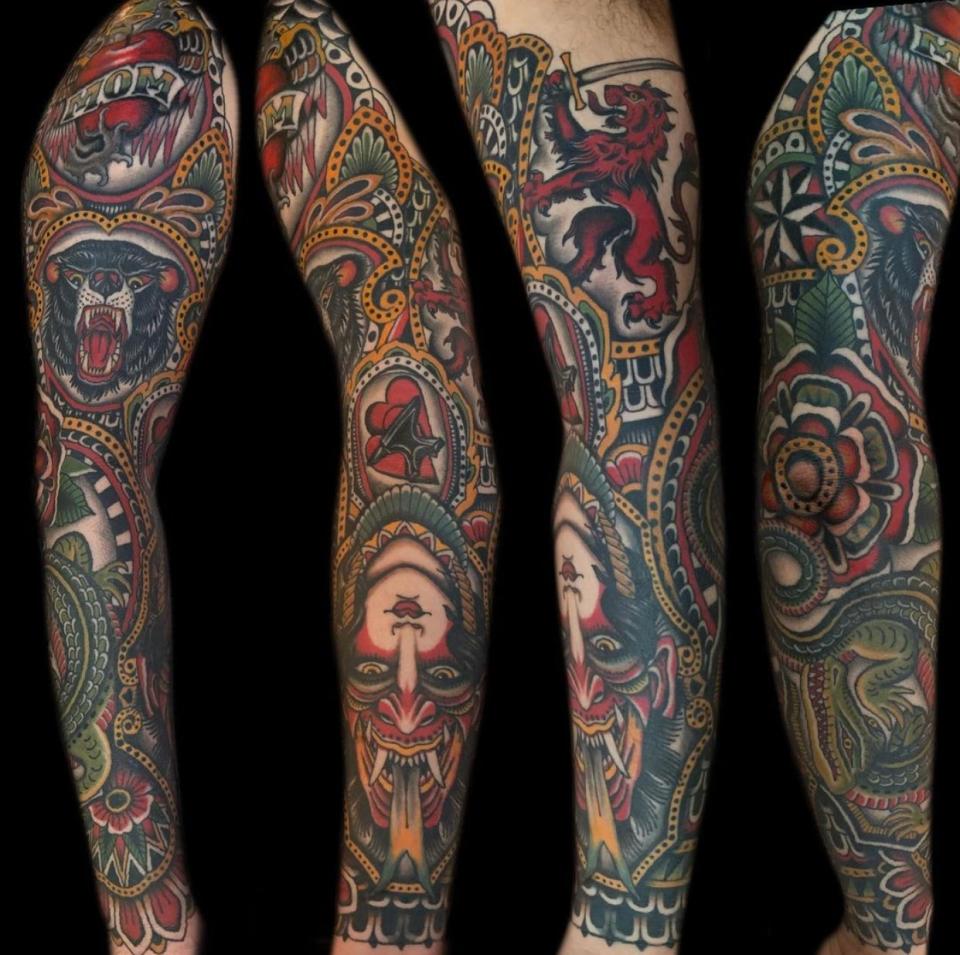How to Curate a Custom Tattoo Sleeve
So many of us with tattoos have found that once we got our first piece, we immediately wanted another — and another, and another. Perhaps, like mine, your first few were spread out on different parts of the body: I started on a calf, then got one on the back of my neck, and jumped to a forearm. I thought that forearm tattoo might end up standing alone, but it wasn't long before I started envisioning what pieces I might want surrounding it and traveling all the way up my arm. It was bound to happen: I was going to start a tattoo sleeve.
Six years after my first tattoo, my right arm is more inked than not. I'm so happy with the beautiful work of the three artists who've contributed to it, and I can't wait to return to them and collect pieces from a few other tattooers. But part of me has always wished I'd taken a little more time before I'd started to truly map out a sleeve plan, and I've wondered if I went about it in the right way.
Well, you may be as relieved as I was to learn there's no one "right" way to do this. But the experts definitely have some tips that are worth keeping in mind before you book your first (or 15th) appointment. I spoke to top tattoo artists to get their guidance on curating your ideal tattoo sleeve, so you can get the answers you need about choosing designs, where to begin, how long it may take, and more.
Where to Start
When you get your first arm tattoo, you may not know at the time that you'll want to add on and create a sleeve, so there's technically no wrong area on which to get your first piece. For those who know they're planning on a sleeve, however, starting-spot trends have changed.
"I was always of the thought that you should start at the top and work your way down. That’s how it was when I started getting tattooed," says Erin Odea, tattoo artist and owner of Crossed Keys Society in Fort Lauderdale, Florida. But she's noticed that a lot of her clients have been starting with their forearms in more recent years, chalking it up to visible tattoos being more widely accepted by employers. "I suppose that works just as well, but it's a little more ballsy."
So, upper arm or forearm? In some cases, the answer is neither. "I like to ask someone what their plans for their elbow are early on," says Becca Genné-Bacon, a tattoo artist at Kings Avenue in New York City. "If they want something circular or symmetrical, like a ship's wheel, I recommend that we start with that."
That said, if you're planning on a patchwork sleeve — meaning a sleeve made up of separate tattoos rather than one big image with a background — those designs may very well determine the locations on your arm that get inked first. "I like to ask what three or four images are the largest, most important ones. I like to start with those, rather than filling up one particular spot on the arm first," Genné-Bacon explains. "The spaces in-between the larger pieces can then dictate what the smaller images are that bring everything together."
Filling in Smaller Spaces
If inking nearly every inch of skin is part of your sleeve goal, you face the challenge of figuring out how to fill the smaller and often oddly shaped spaces between the more prominent pieces. But it's not impossible, and your options are a lot less limited than they may seem as long as you're not expecting to get elaborately detailed art in a tiny area.
"Depending on the size of the areas you're looking to tattoo, a little fun symbol or just little trinkets can go in between big designs," Odea says, noting that flowers are a popular filler choice. "But they need to stay simple to fit in small spots."
Genné-Bacon likes to get accurate tracings and draw for exactly the spot being filled. "Things with more organic edges can be manipulated more easily to fill the spot perfectly," she says.
If you don't have something specific in mind, you may want to consider a classic filler like stars and dots. "Doesn't get better than those. They fit in any space, can be small or big, packed in tight, or spread out," Odea says. "Works like a charm."

Style and Color
There's a wide array of tattoo styles — traditional and neo-traditional, realism, and watercolor, to name just a few — not to mention that tattoos can be done in either colorful or black and gray ink. If you're drawn to several different styles or you're not sure you want to commit to full color from shoulder to wrist, you may be concerned that your sleeve will look like an erratic hodgepodge. But with the right artist (or artists) you can marry different looks to create something you love without compromising your tastes.
Odea likes "collector"-style patchwork sleeves, which often combine different styles and colors based on the individual pieces. "There will be some subject matter you may want that is better suited to black and gray or color, or to realism versus traditional, and that may change your direction midway unless you plan ahead."
Genné-Bacon likes when pieces are consistent, but that doesn't necessarily mean committing to a single style or color scheme. "As long as everything looks purposeful and balanced, I think a mix can look good," she says of combining colorful tattoos with black and gray pieces. If you're mixing styles, however, you may want to stick to something more monochromatic. "I think when there’s a few different styles, keeping things cohesive with all black and gray tattoos looks really great."
Theme
When asked if a sleeve should be limited to a specific theme, both Odea and Genné-Bacon answered the exact same way: "Not at all!"
"It can be fun to stick to a theme, but it’s not a necessity," Genné-Bacon says.

In other words, if you want a tattoo on your forearm that references your favorite obscure horror movie and another on your bicep that pays tribute to your grandmother, there's no reason you shouldn't get both.
"There are so many ways things can come together," Odea says. "You can have some that are similar in color palette or tone, line weight, or illustration style," making completely unrelated concepts gel seamlessly. And that's why it may behoove you to stick to the same artist for the entire arm — or not.
One Artist Versus Several
There are clear benefits to going to one artist for every tattoo that makes up your sleeve. “It definitely keeps it cohesive, and it's also really awesome to build a relationship with an artist throughout the process," Odea says.

It's almost downright necessary to stick to the same artist if your sleeve is a single design. "If you're getting one large image with a background then definitely [use one artist]," Genné-Bacon says. However, a patchwork style doesn't demand loyalty to a single artist. "I love getting to fill someone's arm from start to finish, but I also love getting to see my work mixed in with other artists." As long as you’re picking artists whose work you love and choosing designs that fit around your existing pieces, she says, then the end result can look just as cohesive as going to one artist.

How Long a Sleeve Takes
It probably goes without saying, but if you're going into your appointment with a naked arm, don't expect to leave the studio that day with a full, completed sleeve.
"Most of the time it’s just not possible, whether because of time or the amount of pain," Genné-Bacon says, explaining that she prefers to take sleeves and piece or two at a time — and that's probably wise for your wallet considering most tattoo artists charge by the hour.
Odea concurs, saying there are very few sleeves that can be done in even a very long single day. "Even the most seasoned tattoo collectors have a limit to how many hours they can get tattooed, so I would say to take your time," she says, adding that sleeves can take days and sometimes even years to complete. "It will really depend on how often you can get tattooed, your artist's availability, your stamina and pain threshold, the complexity of your design, and the speed of your tattooer.
More on tattoos:
Now check out 100 years of tattoos:
Follow Marci on Instagram and Twitter, or subscribe to Allure's newsletter for daily beauty stories delivered right to your inbox.
Originally Appeared on Allure

